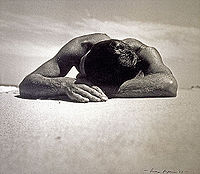- Max Dupain
-
Maxwell Spencer Dupain AC (4 April 1911 – 27 July 1992) was a renowned Australian modernist photographer.
Contents
Early life
Dupain received his first camera as a gift in 1924, spurring his interest in photography [1] He later joined the Photographic Society of NSW, and when he left school, he worked for Cecil Bostock in Sydney.
Career
Early years
By 1934 Max Dupain had struck out on his own and opened a studio in Bond Street, Sydney. In 1937, while on the south coast of New South Wales, he photographed the head and shoulders of a friend Harold Salvage lying on the sand at Cullburra Beach. The shot, entitled Sunbaker, became Dupain's most famous piece.[2]
However, it was not until the 1970s that the photograph received wide recognition. It was purchased in 1976 by the National Gallery of Australia, Canberra and has become an iconic national image.[3]
Later years
During World War II Dupain served with the Royal Australian Air Force in both Darwin and Papua New Guinea as a camouflage officer. The photographs he took at this time could be separated into those that were work-related, and those for his personal collections. Dupain’s experience with the deceptive nature of camouflage during the war appears to have significantly impacted his post-war work, which can be defined by its commitment to truth and clarity. [4]
In 1947, these feelings were reinforced when he read a book Grierson on Documentary which defined the need for photography without pretence. The catchcry was "the creative treatment of actuality". Dupain was keen to restart the studio with this new perspective and abandon what he called the "cosmetic lie of fashion photography or advertising illustration". Refusing to return to the "cosmetic lie" of advertising, Dupain said.
"Modern photography must do more than entertain, it must incite thought and by its clear statements of actuality, cultivate a sympathetic understanding of men and women and the life they live and create."
His documentary work of this period is exemplified in his photograph "Meat Queue". He used a more naturalistic style of photography, "capturing a moment of everyday interaction [rather than] attempting any social comment".[5]
Dupain also worked extensively for The University of New South Wales[6] and CSR Limited and made many trips to the interior and coast of northern Australia.
In the 1950s the advent of the new consumerism meant that there was plenty of promotional photography for advertising and he attracted clients from magazines, advertising agencies and industrial firms. In between this he devoted time to pursue his love of architecture, and began architectural photography which he continued most of his life.
Personal life
In 1939, after the outbreak of World War II, Dupain married Olive Cotton (also a photographer) but they divorced soon after. A decade later, Dupain married Diana Illingworth and subsequently they had a daughter Danina and a son Rex, who also became a photographer.
Dupain continued working until his death in 1992.
References
- ^ "Max Dupain". http://www.tristansgallery.com/showPhotographer/49. Retrieved 23 February 2010.
- ^ http://www.mdaa.com.au/Portals/www.mdaa.com.au/IFrame/people/max-02.html
- ^ "DUPAIN, Max - Sunbaker". National Gallery of Australia. http://artsearch.nga.gov.au/Detail.cfm?IRN=102513. Retrieved 2008-11-25.
- ^ Elias, Ann,"'Camouflage Australia: Art, Nature, Science and War'". http://purl.library.usyd.edu.au/sup/9781920899738.(Sydney: "Sydney University Press". http://sydney.edu.au/sup/., 2011), pp. 165-179.
- ^ "DUPAIN, Max - Meat Queue". National Gallery of Australia. 2008-11-25. http://artsearch.nga.gov.au/Detail.cfm?IRN=95896. Retrieved 2008-11-25.
- ^ O'Farrell, Patrick (1999). "3" (in English). UNSW - A Portrait. University of New South Wales Press Ltd. p. 116. ISBN 0868406171. http://books.google.com/books?id=61sC8otHOoUC. Retrieved 2008-11-24.
Bibliography
For a full list, see [1]:
- Max Dupain’s Australian Landscapes, Mead and Beckett, Australia, 1988.
- Fine Houses of Sydney, Irving Robert; Kinstler John; Dupain Max, Methuen, Sydney, 1982.
- Max Dupain Photographs published by Ure Smith, Sydney, 1948.
External links
Categories:- 1911 births
- 1992 deaths
- Australian photographers
- Architectural photographers
- Companions of the Order of Australia
- People educated at Sydney Grammar School
Wikimedia Foundation. 2010.


